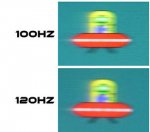Scanlines? updated 10/11/17 - we had a few questions about this since publishing the review so took the chance to go back and do some further testing. On some G-sync screens, including the Acer and Asus 34" models we've talked about a lot in this review, some users complained of a so-called "scanlines" issue when using the G-sync feature. The reports are that when you enable G-sync, some very faint horizontal lines appear on the background, and some users have found this distracting. It seems that the typical "test" for scanlines is to use the NVIDIA G-sync pendulum demo, and look at the grey background while toggling between G-sync on and off settings. This can help you identify and find the scanlines, although it's not really clear whether it's really a major concern in normal uses and gaming. It's all very well specifically looking for it with something like the pendulum demo, but you do need to consider whether it will affect you for actual uses. It seems some reports are that the issue becomes worse at higher refresh rates and with overclocks, although information is a little patchy. A reported official response from Acer on the matter suggests that it is caused by the dynamic refresh rates and changing frame rates which would seem a logical explanation as to why something like this might appear, and only when G-sync is being used. It's not something we noticed during our testing of the Acer and Asus models at the time. Nevertheless, we had the opportunity to specifically search for it here with the AW3418DW. We ran the pendulum demo and switched between G-sync on and off. If you look very closely at the grey background you can see some slight differences. A very faint horizontal pattern appears and you see some slight shimmering of the image on some colours. It is very, very slight, and you can only really detect it if you look very closely at the screen from a short distance. Moving back a typical viewing position makes it very hard, or almost impossible to spot in our opinion. Using the screen without G-sync removes any sign of these slight artefacts. It seemed to be the same faint pattern at all refresh rates, with the 120Hz overclock not making it any different.
We are not sure whether it is any more or less apparent than on the Acer and Asus models since we didn't specifically look for the issue at the time. Our advice would be that if you are super-sensitive, previously had issues with other similar G-sync screens or really found it a major problem for your uses in the past, perhaps it might be a problem for you again here. However, we would say that most users really do no not need to worry about it, it's so subtle that we feel it would be very hard to detect in normal uses, from a normal viewing position and without specifically searching for it. It's probably one of those situations where it's better to not go searching for defects and just enjoy the new screen.








